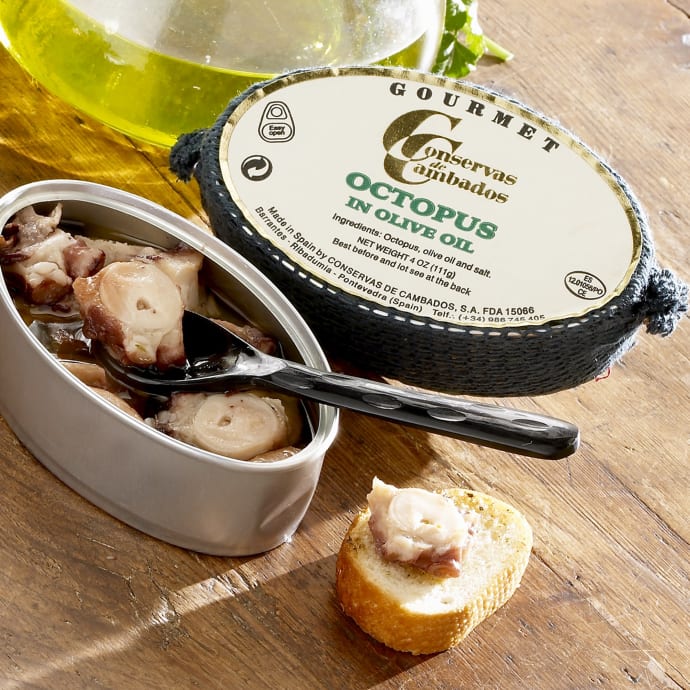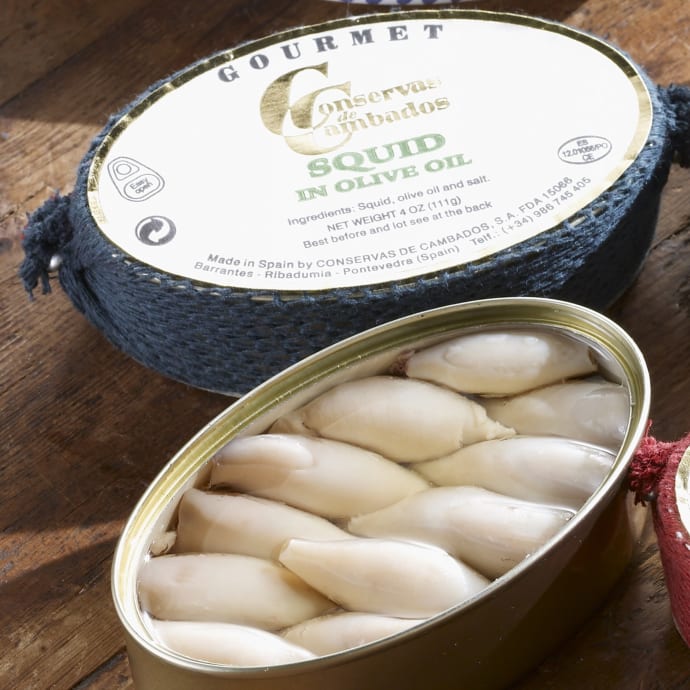About tinned seafood
Bill Addison
Late last week, when I needed a fast lunch, I remembered I had a tin of mussels in pickled sauce on hand.
I’d picked them up while buying wine at Tilda, the new Echo Park bar that has shifted to retail during the shutdown. (My visit became part of a story published this week on how Los Angeles wine bars have pivoted and innovated.) Next to the bottle selection, visible through a glass wall from an adjacent atrium, there were also shelves filled with a small assortment of groceries.
Items included coffee from nearby Canyon roasters, large bottles of Topo Chico and canned beer, olive oil and then — aha — some tinned seafood in beautiful packaging. A few of these would be smart to have around, I thought.
The mussels are from Galicia, Spain, an area famous for its seafood, packed by the Ramón Peña canning factory in a shiny black and gold box. I pulled back the tab on the round tin and savored the pop and metallic scrape while peeling off the lid.
Ten plump mussels lolled in a marinade with a red-siren glow that reminded me of Sichuan chile oil. “Pickled sauce” as a translation doesn’t exactly flatter the technique of Spanish escabeche — cooked seafood cured in a mixture of olive oil, vinegar and spices that usually include mild smoked paprika.
That afternoon, I had neither the time nor the energy for anything beyond eating the mussels straight from the can. Their frank, meaty deliciousness surprised me. I’d had fancy tinned seafood in restaurants before, rounded up with bread and punchy condiments, but it was a moment of grace to enjoy something that was as pleasurable as it was practical.
Americans on the whole haven’t much warmed to seafood conservas, as they’re called in Spain. Plenty of us think only of Chicken of the Sea tuna when we think of tinned fish — that, or anchovies put to service as an umami blast for sauces. Generic sardines tend to linger past their expiration dates in the farthest reaches of kitchen cabinets.
But good tinned seafood has become my favorite at-home quarantine meal hack. When I need something in an instant, eaten on its own, I prefer mollusks — spiced octopus in olive oil, squid in tomato sauce or in squid ink, the vinegary mussels. If I’m eating fish unadorned from the tin, I find it most compelling when it’s smoked.
Sardines (or other common tinned fish like mackerel or trout) have more appeal with simple pairings. Butter a split hunk of baguette and smash the fish into the bread with a fork, then garnish with a squeeze of lemon or a few slivers of pickled onion — whatever briny, acidic addition you might have on hand. Make them the star ingredient in a salad with an intense, mustardy vinaigrette.
Find conservas at Los Angeles markets like Cookbook in Echo Park and Highland Park, Pantry L.A. in Beverly Grove and Broome Street General Store in Silver Lake. Significant for these times, it’s easy to order a broader range of products from online sources.
Start by glancing through the collection from Jose Gourmet, a company whose products I uniformly enjoy, on the comprehensive site of Caputo’s, a market and deli in Salt Lake City. Four-ounce tins start around $8; their boxes include evocative illustrations from Spanish and Portuguese artists. Matiz, carried by Amazon, is another reliable purveyor and usually a little cheaper; seek out its sardines packed with minced piquillo peppers. La Tienda, based in Virginia, is another reliable source.
To remind myself of the options worth seeking out in the first place, I reread the tinned seafood menu descriptions from Saltie Girl in Boston. It’s a seafood bar with one of the country’s finest conserva selections: It’s where I first came to fully appreciate the genre’s breadth and subtleties. Looking forward to the day I can fly across the country and eat there again with a dear local friend. In the meantime, I’ll be at home experimenting with making sardine curry this weekend.
Read full article...





